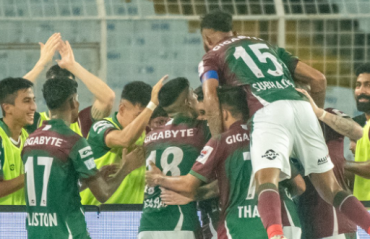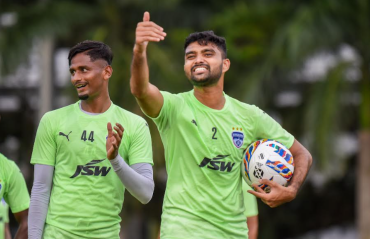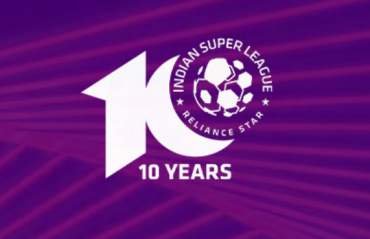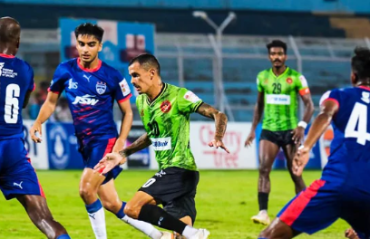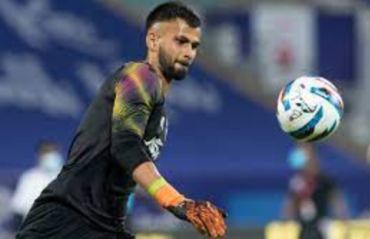Once in a Blue Moon: The club that changed everything
- By Chiranjit Ojha

- July 19, 2015
IN THE LAST TWO YEARS, Indian football has gone through a sea change.
Two years ago, around this time, Indian football had the worn-out appearance of an old circus horse that had used up all its tricks, and could offer nothing new to an audience that was largely ignoring it. Sure, the old tried-and-tested Kolkata Derby, the localised Kerala craze, the Goa rivalry remained alive, but there was little in there to attract newer audience into the sport. Even the appearance of Pune FC, a new club that deserved all the plaudits it got for the professionalism they introduced in running things, seemingly failed to tap into the local community and earn their loyalty.
Even a new tournament proposed by AIFF's commercial partner IMG-Reliance, to be constructed in the lines of cricket's crown jewel IPL, was being greeted with lukewarm response from potential investors.
The urban youth in India's cities were investing their loyalty in European leagues. A large city like Mumbai, where Manchester United, Chelsea and Arsenal fans numbered in thousands, could not offer up a hundred people to attend Mahindra United's matches, leading them to shut shop. I-League was reduced to a competition that was only held and talked about in small pockets of the country. Even getting matches televised was a regular struggle. Indian football, it was often said, was a dying culture, and was pointless to invest in as sponsors or stakeholders.
But two years ago, today, under the cautious eyes of the football loyalists around the country, a new club was born, in a very unusual way, in a city with no pre-existing fan culture around a local football club. Armed with a financially strong backer, a well thought-out marketing plan and a few excellent footballing minds, Bengaluru FC revealed itself to the world, and sprung into an existence where the minimum requirements of success involved pulling off at least half a dozen miracles.
Usually, a football club in India is born small, and takes some time to rise up the ranks. Most of them run on scarce resources, desperately seeking sponsors to exist season to season, which essentially neutralizes their potential to market themselves and attract supporters. Bengaluru FC had the advantage of JSW Sports pouring ample money into the project, and they used it well to make a powerful impact upon arrival. They were the first club to take the Direct Entry route into top division I-League, and immediately signed a spirited young head coach in Ashley Westwood, who as a player came out of the Manchester United youth system, appeared in the Premier League for Bradford City, and later became their assistant manager. They went hard into the transfer market, picking up players with national team repute like Sunil Chhetri, Robin Singh and Lenny Rodriguez, while strengthening their defence with experienced players from England like Curtis Osano and John Johnson. By the time of the much-hyped launching ceremony at Bangalore Football Stadium on 20th July, Bengaluru FC were already looking like a major force in the league.
But it would take more than success on the field for Bengaluru FC to find their foothold. The challenge they faced was to create a loyal and energetic fan culture around the club out of nothing. And they had only a few weeks to do that. This is where the marketing campaigns kicked in, with an innovative and diverse approach hitherto unseen in Indian sports. Apart from the traditional mediums, the club had a large on-line presence. They partnered up with coffee shop chains and restaurants to sell tickets, held events at schools and encouraged personal interactions between players and fans. Quickly they became an intrinsic part of the community, and the city accepted them with open arms.
22th September was a day of reckoning for Bengaluru FC. It was their first competitive game; their I-League campagin opener against Kolkata heavyweights Mohun Bagan. It was a full-house at Bangalore Football Stadium. Apart from local supporters there were a lot of away fans too. As the match wore on, a different game played out on the stands; the voice of the home city spectators slowly became synchronised, countering the visiting fans in unison, slogan for slogan, chant for chant. As the match came to an end in a pulsating 1-1 draw, it was clear that the city had just witnessed the start of something beautiful.
Over the next few weeks the supporters bonded with each other. Strangers became friends, new relationships blossomed, all bound by a single common thread: their love for Bengaluru FC. Fans started forming groups to meet up before home matches or to watch away matches together. Aibor Brewing Company, a bar close to the stadium, became one of the favourite hangouts for BFC fans. The club tapped into the growing fan spirit and made it their official pub. The fans themselves were no less resourceful; organizing themselves, developing matchday traditions like group marches to the stadium, and coming up with songs and chants to cheer every single player in the team. Although a common practice in Europe, India was yet to see a matchday crowd that sang in unison for the duration of the game, until now. Soon a group of loyalists started following the team to their away matches. As the fan support grew, the team matched it with their performance, quickly rising to the top of the points table. As the end of the season came near, Bengaluru FC were at the cusp of history: of becoming the very first club to win the I-League in their debut season.
And the culmination of the dream run happened at Fatorda, in an away match against Dempo. In front of a large group of travelling fans, an action-packed encounter unfolded, with the Blues ultimately coming on top with a 2-4 win, sealing the I-League title for themselves. It was a moment of vindication for the players, the people who worked hard to build the club from ground up, and the fans who had so selflessly offered up their loyalty. Bengaluru FC had done the unthinkable, and written themselves into the history of Indian football.
The team returned to the city as the Champions of India. As the BFC players paraded on an open bus with the I-League trophy adored by legions of fans, the impact of their success was being felt all over the country, and Indian football was about to change forever.
In fact, all through the season, their unprecedented rise in popularity had turned quite a few heads in the corporate world. Potential investors who were unsure about IMG-Reliance's proposed new league were now excited: Bengaluru FC was showing them exactly how to make a football club popular. IMG-Reliance, after postponing their pet tournament multiple times, finally had enough investors to go ahead with bidding for teams in March 2014. By April, 8 cities were selected and Indian Super League was ready to kick off in a few months. Bangalore was among the cities that got a franchise.
This presented a new dilemma for Bengaluru FC. They football culture they had built from scratch was now in danger of being sabotaged by a new franchise in a new tournament which Bengaluru FC, in spite of being the Champions of India, were excluded from. But not to be outdone, JSW's corporate muscles came to BFC's rescue as they started cosying up with the owners of the Bangalore franchise, and IMG-Reliance did not like it at all. In August 2014, the Bangalore franchise was scrapped, and the slot was awarded to Chennai. Bengaluru FC had pulled off yet another miracle: they had driven ISL out of their city. Their turf was now secure. It was time for aiming higher in their second season.
Lots of things changed for Bengaluru FC by the time season 2014-15 came around. They had moved to Kanteerava Stadium, an arena with a natural turf and increased capacity. They were also preparing to play in Asia for the first time. Their campaign got off with the Durand Cup where they reached the semi-finals, losing to Salgaocar in penalties. But by early January they made a spectacular comeback, winning their first ever Federation Cup title. In I-League they got off to a shaky start, but eventually gathered steam and soon caught up with the top three on the league table. In the Asian Champions League qualifier, they put up a fight but lost to Malaysian club Johor Darul Ta'zim 2-1. This sent them to the AFC Cup group stage, where they managed to come second in the group and progress to the knockout stage. In the round of 16, they were paired with South China. In an away match on 26th May 2015, they lost to the Hong Kong Premier League outfit 2-0.
Meanwhile, the I-League title race had set them up for a spectacular final-day finish with the very club they had faced in their first competitve match: Mohun Bagan. Being two points down, BFC needed a win to bag the title for the second time in a row. On 31st May, history came a full circle for the Blues as they went up against the Mariners at Kanteerava. Thousands travelled to Bangalore to witness the match and the 20,000 capacity stadium was filled to the brink. Once again, the vocal fans of Bengaluru FC faced off with their noisy old rivals from Kolkata. On television, millions watched tuned in, making it one of the most watched matches in I-League history.
As rain poured incessantly from the evening sky, the game got underway, a nervy end to end contest from the outset. After many failed attempts, the deadlock was broken right before halftime by John Johnson, who headed in his first ever goal of the season.
Anticipation and hope reached a crescendo as the second half wore on, as Bengaluru FC fans sang their encouragements to their heroes, who were inching closer to yet another historic league victory. But in the nerve-wrecking final minutes, Mohun Bagan got a corner. Sony Norde delivered the ball into the box, and Bagan defender Bello Razaq headed it into the net. Mohun Bagan had, with a last minute goal, secured their first league title in 13 years. And Bengaluru FC, for the first time in their home ground, experienced a major heartbreak.
But the BFC faithfuls redeemed themselves in the face of sorrow. They clapped and cheer their team for the effort they had put in all season. The sense of loss they were going through together made their bond stronger. People who could not hold back their tears were consoled, and as Mohun Bagan lifted the I-League trophy, they were greeted with an applause in true sporting spirit. By being graceful in defeat, Bengaluru FC fans proved their class, and the fact that even though their club was only 2 years old, their supporters did not lack in maturity.
That was some fifty days ago. Today, Bengaluru FC are celebrating their 2nd birthday. They have come a long way in these 2 years. There is a vibrant football culture around the club now, with fans, club-centric events, an junior teams, an academy, grassroot programmes. While the Indian Super League has stolen the spotlight in Indian football, BFC have held their own. Their players now form the majority of the Indian national team. In spite of losing out on the I-League title, they are the most consistent club in India in terms of performance. Their way of administrating and marketing the club remains an example to the rest. They have one of the most loyal fanbases, and footballing rivalries building up with some of the other heavyweight clubs in country. The Blues are true pioneers in the modern game who have helped transform Indian football for the better, for good.
And that's what makes today special. Clubs like Bengaluru FC are rare, and they come along only once in a blue moon. Their methods may be replicated elsewhere, by multiple clubs, to various degrees of success, but they will always be the ones that did it first. They will always be the first club to become Champions of India on their debut season. They will always be the first club that successfully stood their ground against ISL. They will always be the first club in India to have fans who sing throughout the whole game.
They will always be the club that changed everything.









